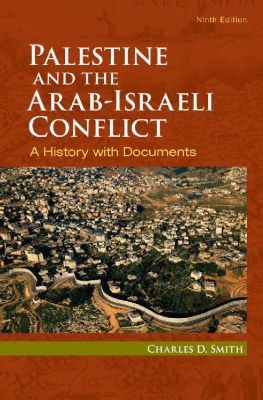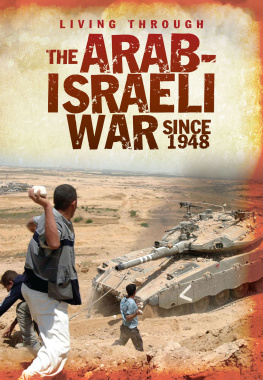
Teaching the Arab-Israeli Conflict
Teaching the Arab-Israeli Conflict
Edited by Rachel S. Harris

Wayne State University Press
Detroit
Copyright 2019 by Wayne State University Press, Detroit, Michigan 48201. All rights reserved. No part of this book may be reproduced without formal permission. Manufactured in the United States of America.
ISBN 978-0-8143-4677-8 (paperback); ISBN 978-0-8143-4676-1 (printed case); ISBN 978-0-8143-4678-5 (ebook)
Library of Congress Cataloging Number: 2019930526
Wayne State University Press
Leonard N. Simons Building
4809 Woodward Avenue
Detroit, Michigan 48201-1309
Visit us online at wsupress.wayne.edu
In memory of
Michael Kotzin, 19412015
Michael Feige, 19572016
Contents
Jacob Lassner
Caitlin Carenen
Janice W. Fernheimer
Martin B. Shichtman
Ashley Passmore
Donna Robinson Divine
Adia Mendelson-Maoz
Marcela Sulak
Ellen W. Kaplan
Beverly Bailis
Ranen Omer-Sherman
Marilyn R. Tayler
Randall G. Rogan
Alan Dowty
Shayna Weiss
Amy Weiss
Olga Gershenson
Cary Nelson
Oren Kroll-Zeldin
Russell A. Berman
Umut Uzer
P. R. Kumaraswamy
Husam Mohamad
Menna Abukhadra
Peter C. Herman
Rachel Feldhay Brenner
Holli Levitsky
Jeffrey Bloodworth
Terri Susan Fine
Ari Ariel
Mira Sucharov
Mya Guarnieri Jaradat
Susan Jacobowitz
Rolin Mainuddin
Liora R. Halperin
Philip Metres
Shiri Goren
Rachel S. Harris
Joel S. Migdal
In 1929, violent rioting broke out in Palestine. This Arab revolt against Jewish immigration and British rule resulted in a week of terror throughout the Mandate. Maurice Samuel, a British Jewish journalist and translator newly arrived in the country, wrote his assessment of the situation in a book that appeared six months after the events and before the official government reports. In order to mitigate the situation, Luke authorized Saunders to recruit every able-bodied British man who was willing to supplement the meager forces.
That summer, forty theology students from Wycliffe Hall were brought by Rev. George Francis Graham Brown (18921942), principal of the Anglican college at Oxford University, who began that excellent scheme of taking parties of young students in his charge to Palestine to get the knowledge that only sight of that land gives. Though one student was shot in the shoulder and was delayed by hospitalization, the others returned to England at the end of the summer to resume their studies.
I first read about this incident as I was preparing my masters thesis as part of my degree in Middle Eastern Area Studies at the School of Oriental and African Studies As I sat in the idyllic surroundings of the English countryside writing more than seventy years later, a wave of suicide bombings were taking place in Israel, whose interpretation in the British, Israeli, Arabic, and Jewish press were framing the contemporary events in light of the regions history. The resonances between the past and the present seemed at the heart of why my work mattered.
Later that year, I began my doctorate in Israeli literature at the University of Oxford and ultimately wrote my dissertation on the ways in which fiction and poetry have commented on national narratives. Between my training (first in Islamic studies as an undergraduate, then Middle Eastern studies, and finally Israel studies) and my research interests, I had arrived at a deep underlying and very personal understanding of the Arab-Israeli conflict that informed my scholarship from thence onward. I believed that studying the historical facts could only tell us part of why the situation was so difficult to navigate socially, politically, and intellectually and that the focus on politics tended to emphasize the perception, ideology, and achievements of the leadership without considering the social and cultural impacts. In turn, this also marginalized the voices that had informed and shaped the mythologization of history. Art, I felt, offered a way to analyze myths and see how they shape our understanding of the past, and ultimately art made space for the voices on the fringes, including women and minorities.
With this in mind, I created my first course, War and Peace in Israeli Poetry, for a continuing-education program for young adults at the Reform Synagogues of Great Britain. Despite the title, the course included poems by Palestinian authors. For, as Liora R. Halperin explains in her essay in this book, Though one may make pretensions to study Israel without Palestine or Palestine without Israel, on the basis of ones topic of interest, the practice of scholarship requires facing both Israel and Palestine. The course was divided into six topics: The Role of the Sabra, Memory and Memorials, Contested Land, Human Relations, Daily Life, and War Cries and Peace Songs, and in later iterations of the course I added A Perfect Peace. The readings included poems by women, Mizrahi authors, disabled authors, and veterans. I have taught it in a variety of guises including public lectures, academic-credit courses, and to undergraduates at two different universities in the United States where I have been on the faculty (SUNY Albany and the University of Illinois at Urbana-Champaign). Later I created a second complementary course, The Arab in Hebrew Literature (which I taught first in England and then in the United States), which explores mainly fiction and includes writing by Palestinian authors who write in Hebrew (Sayed Kashua and Emile Habibi) and a Palestinian author who was born in Lebanon, lives in Britain, and writes in English (Samir El-youssef). The course includes works by Mizrahi authors on the experience of being both Arab and Jewish (Tikva Levi, Sami Shalom Chetrit, and Yechezkel Rachamim). More recently at Illinois, I created an Israeli film course that includes modules on Palestinian films and filmmakers (Hiam Abbas, Elia Suleiman, Suha Arraf, Hany Abu-Assad, and Ibtisam Maraana) and that I have also taught in a variety of adult-education and community settings.
Yet having been deeply embedded in this field for my entire professional academic career, I felt my teaching becoming stale. I was helped by becoming a fellow and participating in the Brandeis Summer Institute for Israel Studies (SIIS), a three-week intensive program for faculty, as have many of the contributors to this volume, but there were few other pedagogical resources available within the field for faculty working in the arts. In recent years, several new textbooks suited for use in history and political science courses have been published, and there is a longer history of resource collections, such as Walter Laqueurs The Israel-Arab Reader: A Documentary History of the Middle East Conflict (1969), now in its eighth, revised and updated edition, coedited with Dan Schueftan (Penguin Books, 2016). Nevertheless, like many such comprehensive resource books meant for classroom use, there is an absence of female voices or documents from other minority groups. There are few comparative works, textbooks, readers, or anthologies designed for university instruction in the many other disciplinary fields in which the Arab-Israeli conflict is taught. There is a dearth of suitable English-language resources for undergraduate (and graduate) courses. For the most part, faculty cobble together courses with homemade readers, trading materials like samizdat. Whereas once conferences were the only opportunity to corner colleagues to discuss teaching, today Facebook has become a space for crowdsourcing suggestions for texts, assignments, and class activities. But as with all social media, the record may be permanent, but finding the informative thread, even a few days later, may prove challenging.
Next page















